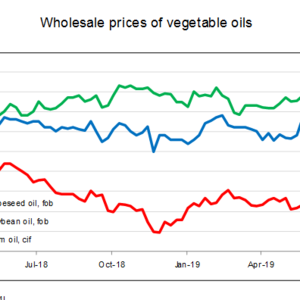UFOP: France bans palm oil from biofuels, Germany should follow

July 24, 2019
BY UFOP
France is tightening up regulations on the use of palm oil as a feedstock in biofuels production. However, this only applies to palm oil eligibility within France. As a result, biofuels produced in France could push their way onto the EU market, toughening supply and price competition.
The French regulation No. 2019-570 published last month ends the eligibility of biofuels such as palm oil methyl ester (biodiesel) and hydrogenated vegetable oil from palm oil (HVO) for public funding. The regulation will come into force on Jan. 1 together with the new tax system. It also provides that as of Dec. 31, economic operators will no longer be allowed to include palm oil-based biofuels in their mass balances.
This provision especially affects the mineral oil group Total. The group only took the refinery at La Mède into operation to produce HVO in July. The plant has an annual capacity of 500,000 metric tons. According to the Total group, the maximum amount of palm oil processed will be 300,000 tons and the minimum amount of rapeseed oil from French production will be 50,000 tons. The remaining supply need of 150,000 tons is to be covered with used oils and animal fats (UCO). In other words, the French government is implementing the authorization regulation introduced by the EU iLUC Regulation (2015/1513/EU) and continued by the revised Renewable Energy Directive (RED II). The regulation allows member states to prepone the phase-out of palm oil-based fuels instead of starting to discontinue their use, based on the quantity sold in 2019, from 2024 onwards and end it altogether by 2030. In this sense, France will fulfil its obligation 10 years earlier.
The Union zur Förderung von Oel- und Proteinpflanzen (UFOP) urges the German government to follow the French example and ban palm oil as soon as possible. UFOP basically welcomes the constraint that excludes palm oil from producers’ mass balances, because biofuels feedstocks must be delivered physically rather than being documented on paper. The feedstocks also fall under the national caps on biofuels from cultivated biomass, which in Germany is 6.5 percent. This is why UFOP fears that there will be shifts in the market if the Total plant eventually produces palm oil-based HVO that will be exported for account purposes in other member states. The international vegetable oil markets are characterized by considerable supply and, consequently, price pressure as it is, the association has emphasized to support its call. The importance of the European biodiesel market is shown in 4 million hectares of rapeseed cultivation and the amount of GM-free high-protein animal feed generated as a byproduct of rapeseed oil production, UFOP has underlined. According to UFOP, the sustainability of soybean production should be doubted, especially since the Brazilian government changed.
Advertisement
Advertisement
According to information published by Agrarmarkt Informations-Gesellschaft (AMI), the Council of Palm Oil Producing Countries, of which Indonesia and Malaysia are members, has announced that it will bring a complaint before the World Trade Organization to challenge the constraint.
Advertisement
Advertisement
Related Stories
The U.S. Department of Commerce has disbanded an advisory committee that provided the agency with private sector advice aimed at boosting the competitiveness of U.S. renewable energy and energy efficiency exports, including ethanol and wood pellets.
Iowa’s Renewable Fuels Infrastructure Program on March 25 awarded nearly $3 million in grants to support the addition of E15 at 111 retail sites. The program also awarded grants to support two biodiesel infrastructure projects.
U.S. operatable biofuels capacity increased slightly in January, with gains for ethanol, according to the U.S. EIA’s Monthly Biofuels Capacity and Feedstock Update, released March 31. Feedstock consumption was down when compared to December.
Effective April 1, Illinois’ biodiesel blend requirements have increased from B14 to B17. The increase was implemented via a bipartisan bill passed in 2022, according to the Iowa Soybean Association.
U.S. farmers are expected to plant 83.5 million acres of soybeans in 2025, down 4% when compared to last year, according to the USDA National Agricultural Statistics Service’s annual Prospective Plantings report, released March 31.
Upcoming Events










